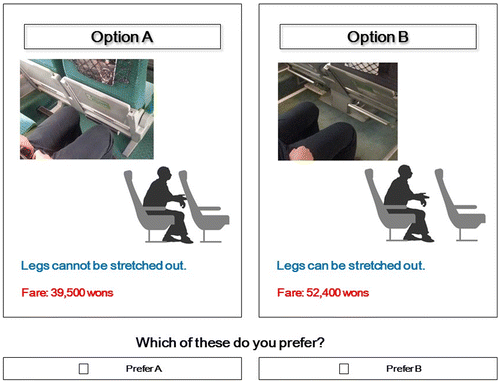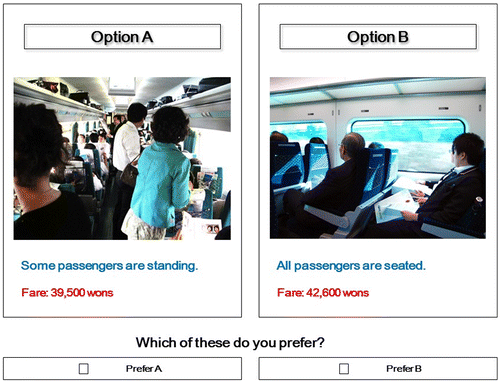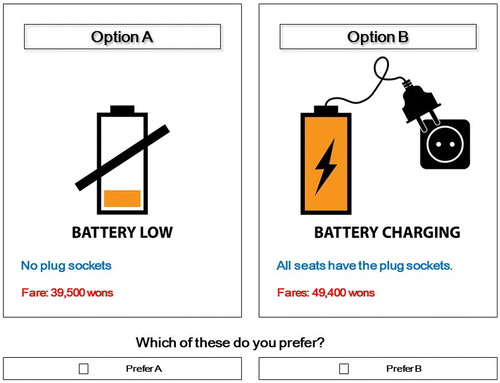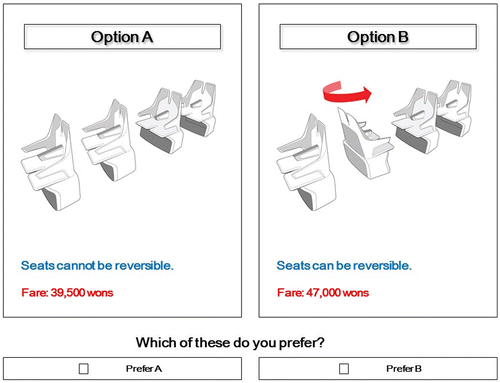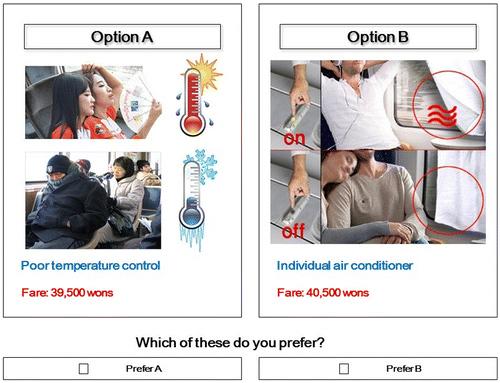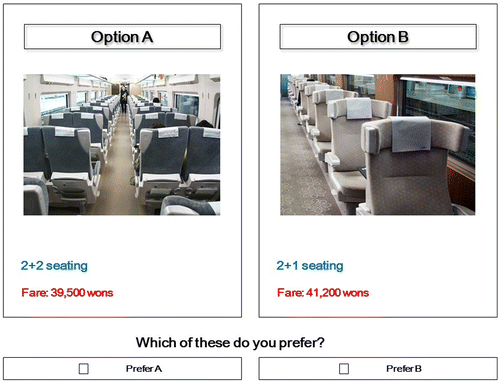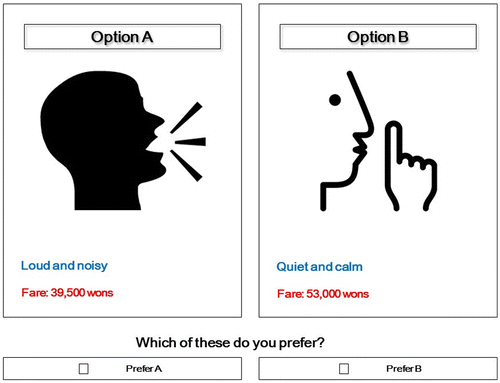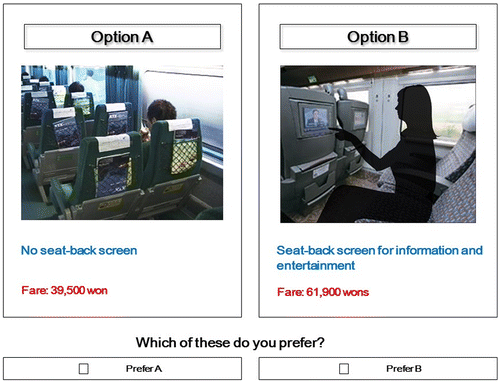Abstract
There have been extensive studies on the monetary valuations for the transit service attributes such as fares, frequency, and in- and out-of-vehicle time. On the contrary, five categories of the elements relating to tangible, comfort, convenience, customer care, and safety and security have not been sufficiently evaluated. This paper explored the valuations based on the service improvements of Korean high-speed rail. The survey for attribute selection identified 11 user-tailored items for the betterment. Factors pertinent to comfort were predominantly preferred. Subsequently, choice experiments were conducted in the form of train-type choices. Binary logit models were then specified and estimated using the data collected. Monetary values were obtained in both individual attributes and a service bundle. Policy implications were also investigated in terms of price discriminations. The direction for future studies, particularly in examining user heterogeneity, was finally suggested.
Introduction
High-speed rail services in Korea have drastically changed the intercity transport system of the country. Daily patronage in 2014 was around 150,000, which is approximately three times greater than that in 2004, when the service was launched. Its comparative advantage is particularly noticeable in long-distance journeys. For example, the modal share of railways for the Seoul–Busan trips, which are 424 km long and have the largest intercity ridership in Korea, has increased from 38% in 2004 to 69% in 2014. Air share, in contrast, has dropped from 32 to 15% during the same period. This rapid travel system has also contributed to the growth of the regional economy. Land values for the beneficiary cities have shown higher rate of increase than those of non-serviced towns. Creation of new jobs in tertiary employment for cities with high-speed rail stations has also exceeded the national average (Korea Transport Institute Citation2014).
However, customers require better quality of service for this most expensively priced ground travel mode in Korea, even though they are generally satisfied with travel time savings by this train (Chang et al. Citation2011). Hence, the operator, or Korail, is considering user-tailored service improvements relating to the types of tangible, comfort, convenience, safety and security, and customer care. These target elements are beyond the conventional transit service factors such as fares, frequency, and in- and out-of-vehicle time. Thus, quality of service in this paper represents the five categories of elements other than the traditional attributes.
Better quality of service is more attractive to potential passengers and can generate greater patronage, but it normally entails higher costs. In particular, quality of service depends to a great extent on the operating decisions made by the transit agency within its budget constraints. Thus, the identification of user-preferred service attributes and its corresponding valuation can be a prerequisite for making the decision, which is the primary motivation of this paper.
Literature, however, does not supply sufficient evidence on the monetary values for the service attributes. Three observations pertinent to the purpose of this paper are noted. First, extensive studies can be found that deal with the measurement for transit services, but they normally involve the performance assessment with grades or scales to monitor and control the quality of service provided to the passengers; see, for example, Chang et al. (Citation2011), Kittelson & Associates, Inc., Parsons Brinckerhoff, KFH Group, Inc., and Texas A&M Transportation Institute (Citation2013), Nathanail (Citation2008), and; Wiley, Maoh, and Kanaroglou (Citation2011). Second, the existing research is normally based on urban (Hensher, Rose, and Collins Citation2011), suburban (Basu and Hunt Citation2012; Lu, Fowkes, and Wardman Citation2008; Pepper, Spitz, and Adler Citation2003; Wardman and Whelan Citation2001), or both (Polydoropoulou and Ben-Akiva Citation2001; Wardman and Murphy Citation2015) traffic flows, but it is not very easy to find studies that treat intercity travels in the context of quality of service. Finally, indeed a few studies (Pepper, Spitz, and Adler Citation2003; Wardman and Murphy Citation2015; Wardman and Whelan Citation2001) report money values for several attributes, the majority (Basu and Hunt Citation2012; Hensher, Rose, and Collins Citation2011; Li and Hensher Citation2011; Lu, Fowkes, and Wardman Citation2008; Polydoropoulou and Ben-Akiva Citation2001; Wardman and Whelan Citation2011) however focuses on evaluating crowding inside buses and/or trains. This paper, on the other hand, aims at comprehensive coverage of components in valuing quality of service for intercity rail travel in Korea.
The next section describes the methodology adopted in this paper. The platform is the two-stage survey including attribute selections and contingent choices. Subsequently, valuations on service improvement are presented. Starting from the modeling framework employed, the report for results and the discussion regarding policy implications are the order of this section. Finally, the concluding remarks contain the summary of research and the direction for future studies.
Survey
This section describes the two-stage survey adopted in this paper. The survey for attribute selection identifies passengers’ preferences on the factors affecting quality of service for intercity rail travels. The subsequent choice experiments supply the input data for monetary valuations on the selected elements.
Attribute selection
There are lots of factors affecting rail quality of service, as shown in Table . The list is heavily dependent upon Chang et al. (Citation2011) with the addition of the studies in Table . It would be impractical to consider all involved items. This research thus decided to select representative service attributes. The survey for the selection of items was separately conducted for professionals and the public. This design was proposed out of the hypothesis that the two groups could show different preferences. Sixty-one experts of rail planners and engineers were interviewed. Two hundred and eighty-five laymen were surveyed through internet-based questionnaire. Each respondent was asked to select 10 most important attributes of quality of service for intercity rail travel. The priority was the factors affecting travel comfort. Eleven asterisked items were selected for valuation based on the total votes. The 11th preferred element, or back-seat screen, was added since a marginal difference was recorded between the 10th and 11th attributes. There were no significant differences in preferences between professionals and ordinary travelers against the hypothesis, even though the order of importance in the attributes was somewhat dissimilar. It should also be noted that respondents may differently interpret the service items since the screening was administered in a descriptive manner, particularly in the web-based survey. Thus, the resulting selection may be biased, which is one of the limitations of this research.
Table 1. Candidate of service attributes for valuation.
Table 2. Some collections of related studies.
Contingent choices
The questionnaire comprised travel characteristics, socioeconomic properties of respondents, and stated preference surveys, as shown in Table . It was a person-to-person interview done in August 2014. Four hundred high-speed rail travelers were surveyed. Their socioeconomic properties are summarized in Table .
Table 3. Survey components.
Table 4. Socioeconomic characteristics of samples.
Choice experiments are the primary platform for the survey in this paper. This stated preference technique is popularly used to monetize non-market goods. Most related studies have also adopted this approach, as shown in Table . Figure is an example of contingent choices conducted in this paper. It was a photograph-based exercise with subsidiary artist impressions. Experiments using tables (Chang Citation2010; Pepper, Spitz, and Adler Citation2003; Polydoropoulou and Ben-Akiva Citation2001) or diagrams (Hensher, Rose, and Collins Citation2011; Wardman and Murphy Citation2015) are found in the literature, but the realistic images can more effectively convey the survey information to respondents. Comparative images with or without service improvements were located in the middle. Auxiliary texts were also added to explain the differences in quality of service. The experiment is hence based on an abstract choice context involving a within-mode comparison of different train alternatives. This design could excessively deliver the merit and demerit of service attributes. The simplified design however is helpful in placing a clear emphasis on the quality of service.
Fares that were the payment vehicle in this research were supplied on the bottom. The core of choice experiments would be the setup of the levels for this bottom-line item. An open-ended question was applied to draw the temporary levels of fares for this experiment. The preliminary survey contributed to range the upper and lower limits of levels. The final levels, as shown in Table , were determined after a series of pilot surveys done in July 2014. Since there are only two alternatives that contain the varying levels of attribute each, the full factorial design was adopted. In general, an experimental design aims at maximizing the amount of information on the parameters of a distribution under study. Two desirable properties of estimates for the parameter would be consistency and efficiency. Consistent designs are congruous with real preferences while efficient designs seek to minimize the standard errors of the parameter estimates. Not just the factorial approach but also methods that require prior information over the parameter such as D-efficient designs have been found in the literature; see, for example, Rose and Bliemer (Citation2009). However, no universal method for optimal design has been established yet. The examination for the optimality is beyond the scope of this paper. Empirical treatment for an acceptable design based on the full factorial design was considered in three ways. The first is to increase the sample size, which has the effect of reducing both bias and variance. The 400 samples collected in this study represented the first property. Second, since excessively high or low levels inflate the variance of estimates, keeping the level away from the tails of a distribution can be helpful for good designs. A series of pilot interviews were endeavored along with the preliminary survey to reduce the extreme values for levels. The final treatment is to involve the ratio of parameters because the bias in its estimates is substantially smaller than that of the individual parameters (Hanemann and Kanninen Citation1999). The proposed marginal rate of substitution that will be discussed in the next section addressed this requirement.
Table 5. Levels of fares in the choice experiments.
In the actual survey, the set of levels was replicated to check variability and consistency in answers. Each respondent was then given a randomly selected questionnaire. Blocking, in the form of on/off peak spreading, was also considered to remove the effect of nuisance factors.
The methodology of survey adopted in this paper belongs to the stated preference technique, and hence biases such as hypotheticality, neutrality, and judgment are inevitable during the interview. However, the propensity to which respondents strategically behave to achieve a more desired outcome must be controlled. This issue has also been discussed in the valuation of rail quality of service (Lu, Fowkes, and Wardman Citation2008; Wardman and Whelan Citation2001). A useful measure for relaxation is to keep the property of incentive compatibility (Carson and Groves Citation2007). Since the valuation in this study deals with a public good with coercive payment, the responses are incentive compatible. This means that the problem of strategic responses does not seriously affect the result.
Valuation
Binary logit model
Respondents were asked to select the preferred option between two discrete alternatives in the experiment of contingent choices. The binary logit model is thus a reasonable framework to deal with the data collected; note that most studies in Table have also adopted the logit-based random utility model.
Model of service attribute
Consider a service attribute that is associated with the travel option m as faced by the decision-maker n, namely . This attribute is an element that forms a service bundle
. The utility of alternative m with service attribute
for individual n, or
, is given by
(1)
where and
are the deterministic and stochastic components of the utility, respectively;
represents fares of alternative m perceived by n; and
is the vector of parameters that should be estimated.
Two comments on Equation (Equation1(1) ) are added. First,
is a dummy variable. It takes value 1 for the improved rolling stock and 0 otherwise. The variable can be understood as an alternative specific constant. All else being equal, the constant in the logit model reflects the mean of the difference between the error terms, that is, the gap in the utility between the alternatives. Two options in the choice exercise were only disparate in the service attribute. Thus, the utility difference is caused by the service factor. The estimate for this dummy hence expresses the service improvement. Second, in general, when a new variable is added to the utility function, an interaction effect with the existing factors can appear. For example, the confounding effect between the variables of quality of service and travel costs may be expected. The effect is not considered in this section, but will be discussed more in details at conclusion.
The linear-in-parameters utilities are popularly applied to guarantee the global solution for parameters.(2)
The values of service attribute () are then calculated by the marginal rate of substitution.
(3)
The utility function discussed thus far just contained fares and service element. As mentioned, this specification is useful for placing a clear emphasis on the service attribute of rolling stocks. However, the benefit of train improvements in terms of quality of service can vary according to the travelers’ characteristics. Changes in the specification of model can represent this variation.(4)
where is the kth socioeconomic feature of traveler n and βk is the corresponding parameter.
βk reflects the differences in preferences for train type as the function of . For any given individual,
is in fact constant. It would make no sense to define these variables in both alternatives because all that matters is the effect of
on the relative utility. Thus,
is specified as an alternative specific variable in the utility function. As a result, the simple marginal rate of substitution between the variables of fare and attribute is the willingness-to-pay of the reference group. That is, the amount is only associated with the benchmark trip-makers who do not bear the set of features
. However, the extended specification is useful in addressing the benefit by user group, specified by
. As βk/βc is the marginal effect in willingness-to-pay of people associated with
relative to the reference group, (βk/βc) × μk is the corresponding utility difference of the stratum to the reference group where μk is the mean of
computed across the entire sample. Thus, the average money value for service attribute
using the extended formulation is calculated by
(5)
Model of service bundle
It would be more common that a few service attributes are improved together as a package rather than a single element is just upgraded. The deterministic utility for the case of service bundle is expressed by replacing with
in Equations (Equation2
(2) ) and (Equation4
(4) ). The corresponding values of service bundle, or
and
, are also evaluated by substituting βb for βa in equations (Equation3
(3) ) and (Equation5
(5) ) where βb is the parameter for
.
The value for the improvement in each attribute in a package sums to an amount which is considerably different from the amount that the same respondent assigns to the bundle. Namely, there is an upper limit on how much people are willing to pay for the betterment no matter how many there are (Steer Davies Gleave Citation2000). The precise causes for the effect still remain unclear, even though interactions, budget constraints, halo effects, and the artificial nature of stated preference exercises are often discussed in the literature (Wardman and Whelan Citation2001). Treatment to mitigate the packaging effect has also not been established. The strategy adopted in this paper is, based on the assumption that the valuations of specific attributes are unbiased in relation to each other, to rescale the values so that they sum to a separately estimated amount of the entire bundle.(6)
where and
are the values of a service attribute rescaled by the capping values
and
, respectively.
Results
Speciation and estimation
Two groups of binary logit models were specified (Tables and ) and estimated. One set was the models of 11 different attributes and the other was those of service bundle. The service bundle was the package that included all 11 elements. The bundle does not have to accommodate all 11 items, but can embrace some of them or more depending on research purposes. The models for specific attributes only considered the basic variables of fares and service elements. The bundle model, on the other hand, included the basic factors and also the socioeconomic covariates for travelers. This design does not mean that only the package model can have the socioeconomic variables, but should be understood as an illustration for incorporating covariates in the process of modeling. Two points about the bundle model to be noted are: first, some other variables such as gender and age were initially considered but were finally excluded because they did not show statistical significance; and second, the business–nonbusiness split of which market segmentation is useful to check the variations in behavior by trip purpose was also applied.
Table 6. Specification of the binary logit model for service attribute.
Table 7. Specification of the binary logit model for service bundle.
Tables show the 11 estimation results for the binary logit model of individual service attributes. Although they were simplified analyses just considering the basic specification, the 11 models show the reasonable goodness-of-fit. The formal significance indices of the likelihood ratio statistics indicate that the null hypothesis – that all the parameters are zero – can be rejected at the 0.01 level of significance. The values of ρ2, though they are an informal goodness-of-fit index, are also at an empirically acceptable level. Not just the overall goodness-of-fit but also the reasonableness of each parameter should be checked. All the coefficients in the model estimates have the expected signs. That is, the coefficients for travel impedance and quality of service were negatively and positively estimated, respectively. The t-statistics for independent variables across all 11 models also show the satisfactory precision of estimated coefficients.
Table 8. Estimation results for binary logit model of service attribute.
In Table , the estimation result for the model of service bundle is given. The two results also show the satisfactory goodness-of-fit in terms of the sign and variance of variables and the entire significance of the model in both the formal and informal measures. The extended model, however, performs slightly better. A remarkable observation is the minus coefficient for the variable of number of uses for high-speed rail. The result is read as frequent users are relatively not very keen on the improvements in quality of service. The coefficient of this variable can logically take either sign. However, the finding would mean that the critical determinant for existing users to choose travel modes is not the service attributes that are dealt with in this study but other properties such as travel time savings for spatial interactions. In contrast, the service betterment would be appealing to attract new patronage since the negative sign can indirectly refer to the positive impact on non-frequent riders.
Table 9. Estimation results for binary logit model of service bundle.
Values
Table summarizes the values of travel time and service bundle computed from the parameters estimated in this study. The weighted averages for the values of time and quality of service are also given in the table. The official share in trip purposes of Korea (Korea Ministry of Land, Infrastructure and Transport Citation2013) was applied to this computation; the ratio is business 38.4 and nonbusiness 61.6%, respectively. The values of travel time for business and non-business trips estimated by this study is relatively less and greater than those by the recommendations of the Korean government.
Table 10. Values of travel time and service bundle (2014 prices).
Several comments are given on the results in Table . First, and
show very close amounts. This outcome can indicate the robustness of the estimates. Second, journey purpose has an expected influence on the values while the gap is narrower in the monetary values for quality of service. However, the absolute difference in the value of time gets bigger in the long-distance travels whereas the divergence becomes smaller in the short-distance trips. This is because the service quality is measured by the unit of trip, while the total money values of time is calculated by multiplying travel times consumed. Third, the extended model can supply the user specific amounts of willingness-to-pay, applying the corresponding mean of samples shown in Table . Diverse combinations in addressing willingness-to-pay can be explored. The highest group in business trips, for example, is professionals or employee in tertiary industries whose monthly income is over five million wons. Their amounts reach 24,665 wons. In contrast, trip-makers who frequently use high-speed rail, whose jobs are beyond professionals or employee in tertiary industries, and whose monthly income is below five million wons are only willing to pay 7792 wons on train improvement. This value is around 30% of that of the highest respondents.
Table 11. Sample mean by socioeconomic characteristic.
The valuations on the individual attributes are arranged in Table . The table contains the set of monetary quantities in both per trip and per passenger-kilometer. The unscaled per trip values were obtained from the estimates in Table applying Equation (Equation3(3) ). The weighted average of
in Table , or 17,600 wons, was used as the capping value to evaluate the scaled amounts; note that the business–nonbusiness segmentation was designed to the bundle model, while the service attribute models were based on total trips.
can also be applied in this calculation without any loss of generality. Another weighted average in Table representing the mean distance traveled, which was computed using the responses of samples, was applied for evaluating the value per passenger-kilometer.
Table 12. Values of service attributes (2014 prices in wons).
Table 13. Calculation of average distance traveled.
Two important findings are noted in the result of Table . Above all, the capping value is just 18% of the simple sum of the individual worth unscaled. This gap demonstrates the need for the maximum willingness-to-pay in the stated preference interview. Subsequently, the attributes in the category of comfort show higher values than those of tangible and convenience defined in Table . This consequence is consistent with the outcome of the survey for attribute selection. The priority hence can be given to the group of comfort in quality of service when an operator of railways supplies the improvement of rolling stocks.
Policy implications
This section illustrates two policy implications from the results of this paper. They are all related to price discrimination. One is by the difference in travel times and the other is that in quality of service.
Premium fares and discounted charges by travel time
High-speed rail service in Korea is supplied by the very similar level of ticket prices, even though significant differences in travel time are posted in the time-table. The gap in travel time is mainly attributed to the different portions of usages for the high-speed tracks. Namely, some trains still run a considerable part of their route on the conventional tracks upgraded (Chang and Lee Citation2008). The diverse skip-stop operation is another cause for the difference. This study has proposed premium fares and discounted charges for services requiring longer and shorter travel times relative to those of most frequent operation, respectively. The cases of the longest and shortest travel times by origin-destination pair are exemplified in Table . The weighted value of travel time shown in Table was applied to this evaluation.
Table 14. Price discrimination by travel time.
The reasonableness of first-class fares
Currently, first-class service is available on four of the 18 coaches in Korean high-speed rail. Six of the 11 attributes valued in this paper are provided: seat spacing, in-train cleanliness, plug sockets for laptops or mobiles, seating direction, seating layout, and man-made noise. Table compares the reasonableness of first-class fares with respect to the willingness-to-pay of travelers. People indeed have the intention of paying extra money for first-class service. The amount however is below the price levied. Thus, it can be suggested that first-class service can be expanded subject to lowering the premium. The financial viability should also be checked before the expansion. This is because the improvement itself needs further investment costs and may reduce ridership due to the increases in fares.
Table 15. Willingness-to-pay on first-class service (2014 prices in wons).
Conclusion
This study was conducted to monetize the improvement on quality of service for intercity rail travel in Korea. The survey for attribute selection identified 11 most preferred factors for quality of service. Travelers’ preferences on the betterment of rolling stocks were collected through the application of choice experiments. The data were applied into the binary logit model for train type choices. The values in both individual attributes and service bundle were estimated. In particular, the maximum willingness-to-pay was considered as the capping value for scaling the individual money amounts. Policy implications in terms of price discrimination were also investigated. These suggestions can demonstrate the reasonableness and flexibility of the result by this paper.
This paper can be a useful reference for pertinent studies in general as well as the pricing policy of rail operators. However, greater examination on travelers’ taste variations can provide more opportunity to appreciate the values of transit quality of service. This is simply because the value or importance that individuals place on each attribute is expected to vary depending on the decision-maker. This study incorporated market segmentation in trip purpose, but the trial could partly capture the heterogeneity. The limitation was resulted from the methodology adopted in this research. The survey and theory of the binary logit model are discrete nature-based. The estimated model however implicitly assumed the same model structure and values of the unobserved parameters for all members of population represented by the sample collected. Two approaches can be found in the literature (e.g. Train Citation2009, 42–45) to account for taste variations. First, taste variations that vary systematically with respect to observed variables can be incorporated in the logit model. For example, willingness-to-pay on the service improvement may depend on travel time spent. This can be addressed by adding an interaction term as the product of the variable for service feature as well as for travel time. In contrast, heterogeneity that varies with unobserved variables cannot be handled in the standard logit framework. Mixed logit models in this case can be applied to capture the random taste variations. These explorations are thus the useful themes for follow-up studies.
Disclosure statement
No potential conflict of interest was reported by the authors.
Acknowledgement
The authors are grateful to Mr. Tufail Ahmad for his useful comments for this study.
References
- Basu, D., and J. D. Hunt. 2012. “Valuing of Attributes Influencing the Attractiveness of Suburban Train Service in Mumbai City: A Stated Preference Approach.” Transportation Research Part A: Policy and Practice 46: 1465–1476.
- Carson, R. T., and T. Groves. 2007. “Incentive and Informational Properties of Preference Questions.” Environmental and Resource Economics 37: 181–210.10.1007/s10640-007-9124-5
- Chang, J. S., and J.-H. Lee. 2008. “Accessibility Analysis of Korean High‐speed Rail: A Case Study of the Seoul Metropolitan Area.” Transport Reviews 28: 87–103.10.1080/01441640701421495
- Chang, J. S. 2010. “Assessing Travel Time Reliability in Transport Appraisal.” Journal of Transport Geography 18: 419–425.10.1016/j.jtrangeo.2009.06.012
- Chang, J. S., S. Lee, H. Kim, and D. Jung. 2011. “Review on Quality of Service Factors for Rail Travels.” Journal of Environmental Studies 50: 141–157 (in Korean).
- Hanemann, M., and B. Kanninen. 1999. “The Statistical Analysis of Discrete-response CV Data.” In Valuing Environmental Preferences, edited by I. Bateman and W. Kenneth, 302–441. New York: Oxford University Press.
- Hensher, D. A., J. M. Rose, and A. T. Collins. 2011. “Identifying Commuter Preferences for Existing Modes and a Proposed Metro in Sydney, Australia with Special Reference to Crowding.” Public Transport 3: 109–147.10.1007/s12469-010-0035-4
- Kittelson & Associates, Inc., Parsons Brinckerhoff, KFH Group, Inc., and Texas A&M Transportation Institute. 2013. Transit Capacity and Quality of Service Manual. 3rd ed, Transit Cooperative Research Program Report 165. Washington, DC: Transportation Research Board.
- Korea Ministry of Land, Infrastructure and Transport. 2013. National Guidance on Transport Appraisal. 5th ed. Gwacheon: Korea Ministry of Land, Infrastructure and Transport. (in Korean).
- Korea Transport Institute. 2014. Ten-year Anniversary of Korea Train Express: Changes and Challenges. Press release. Ilsan: Korea Transport Institute. (in Korean)
- Li, Z., and D. A. Hensher. 2011. “Crowding and Public Transport: A Review of Willingness to Pay Evidence and its Relevance in Project Appraisal.” Transport Policy 18: 880–887.10.1016/j.tranpol.2011.06.003
- Lu, H., T. Fowkes, and M. Wardman. 2008. “Amending the Incentive for Strategic Bias in Stated Preference Studies: Case Study in Users’ Valuation of Rolling Stock.” Transportation Research Record: Journal of the Transportation Research Board 2049: 128–135.10.3141/2049-15
- Nathanail, E. 2008. “Measuring the Quality of Service for Passengers on the Hellenic Railways.” Transportation Research Part A: Policy and Practice 42: 48–66.
- Pepper, J., G. Spitz, and T. Adler. 2003. “Customer Perspectives on Multilevel Coaches for Increasing Rail System Capacity.” Transportation Research Record: Journal of the Transportation Research Board 1838: 19–29.10.3141/1838-03
- Polydoropoulou, A., and M. Ben-Akiva. 2001. “Combined Revealed and Stated Preference Nested Logit Access and Mode Choice Model for Multiple Mass Transit Technologies.” Transportation Research Record: Journal of the Transportation Research Board 1771: 38–45.10.3141/1771-05
- Rose, J., and M. Bliemer. 2009. “Constructing Efficient Stated Choice Experimental Designs.” Transport Reviews 29: 587–617.10.1080/01441640902827623
- Steer Davies Gleave. 2000. Rail Passenger Quality of Service Valuations. London: Shadow Strategic Rail Authority.
- Train, K. E. 2009. Discrete Choice Methods with Simulation. New York: Cambridge University Press.10.1017/CBO9780511805271
- Wardman, M., and G. Whelan. 2001. “Valuation of Improved Railway Rolling Stock: A Review of the Literature and New Evidence.” Transport Reviews 21: 415–447.10.1080/01441640010020115
- Wardman, M., and G. Whelan. 2011. “Twenty Years of Rail Crowding Valuation Studies: Evidence and Lessons from British Experience.” Transport Reviews 31: 379–398.10.1080/01441647.2010.519127
- Wardman, M., and P. Murphy. 2015. “Passengers’ Valuations of Train Seating Layout, Position and Occupancy.” Transportation Research Part A: Policy and Practice 74: 222–238.
- Wiley, K., H. Maoh, and P. Kanaroglou. 2011. “Exploring and Modeling the Level of Service of Urban Public Transit: The Case of the Greater Toronto and Hamilton Area, Canada.” Transportation Letters 3: 77–89.10.3328/TL.2011.03.02.77-89
Appendix
Contingent choices conducted in this study
Just one combination of fares for the alternatives is noted as an illustration (see Figures ).

